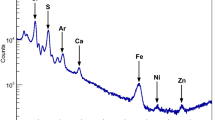Abstract—We investigate the physical reason of the found difference in the flux density calibration for the space radio telescope on the “primary” calibrators Cassiopeia A and Crab Nebula. Twenty internal noise sources (or noise generators) of space radio telescope are analyzed as “secondary” standards measured relative to the “primary” ones in the units of the Noise Source spectral Equivalent Flux Density (in Jy). This is performed within three accurate flux density scales using monitoring data of space radio telescope calibrations at the wavelengths of 6.2, 18 and 92 cm in 2015–2018. The aims are: (1) to find and eliminate the cause of this discrepancy; (2) to propose a method for verification of flux densities of the calibrators and their scales based on the analysis of Noise Source spectral Equivalent Flux Density; (3) to analyze the System spectral Equivalent Flux Density of the space radio telescope. We have found out that the difference is a result of a variability of “primary” calibrators which is accurately quantified by the new scales proposed in 2014 and 2017. The Noise Source spectral Equivalent Flux Density measured within the new scales turned out to be more accurate than results obtained in the 1977 scale. Averaging these Noise Source spectral Equivalent Flux Density on Crab Nebula and Cassiopeia A eliminates the difference between the scales. The space radio telescope noise sources can be used to verify the quality of calibrators. An artificial standard noise source of a radio telescope can be used not only as an ordinary “secondary” calibrator but also as an indicator of relative accuracy for verifying spectral flux density calibrators and scales under certain conditions.


Similar content being viewed by others
REFERENCES
J. W. M. Baars, R. Genzel, I. I. K. Pauliny-Toth, and A.Witzel, Astron. and Astrophys. 61, 99 (1977).
R. G. Conway, K. I. Kellermann, and R. J. Long, Monthly Notices Royal Astron. Soc. 125, 261 (1963).
A. N. Ermakov and Yu. A. Kovalev, Transactions Inst. Applied Astronomy RAS 54, 21 (2020).
A. N. Ermakov, Y. A. Kovalev, and V. I. Vasilkov, in Proc. XVIII Young Scientists Conf. on Fundamental and Applied Space Researchers, Moscow, Russia, 2021, Ed. by A. M. Sadovski, pp. 31–45 (IKI RAS, Moscow, 2021).
G. E. Forsyte, M. A. Malcolm, and C. B. Moler, Computer methods for mathematical computations (Prentice-Hall, Inc., Englewood Cliffs, 1977).
V. P. Ivanov, A. V. Ipatov, I. A. Rakhimov, et al., Astronomy Reports 62 (9), 574 (2018).
N. S. Kardashev, V. V. Khartov, V. V. Abramov, et al., Astronomy Reports 57 (3), 153 (2013).
K. I. Kellermann, Astrophys. J. 140, 969 (1964).
K. I. Kellermann, I. I. K. Pauliny-Toth, and P. J. S.Williams, Astrophys. J. 157, 1 (1969).
Y. A. Kovalev, V. I. Vasil’kov, A. N. Ermakov, et al., Transactions of IAA RAS 54, 32 (2020).
Y. A. Kovalev, V. I. Vasil’kov, M. V. Popov, et al., Cosmic Research 52 (5), 393 (2014).
Y. Y. Kovalev, N. A. Nizhelsky, Y. A. Kovalev, et al., Astron. and Astrophys. Suppl. 139, 545 (1999).
A. D. Kuz’min and A. E. Salomonovich, Radioastronomical methods of antenna measurements (New York, Academic Press, 1966).
L. I. Matveenko, N. S. Kardashev, andG. B. Sholomitskii, Radiophysics andQuantum Electronics 8 (4), 461 (1965).
M. Ott, A. Witzel, A. Quirrenbach, et al., Astron. and Astrophys. 284, 331 (1994).
B. Partridge, M. López-Caniego, R. A. Perley, et al., Astrophys. J. 821 (1), id. 61 (2016).
R. A. Perley and B. J. Butler, Astrophys. J. Suppl. 204 (2), id. 19 (2013).
R. A. Perley and B. J. Butler, Astrophys. J. Suppl. 230 (1), id. 7 (2017).
D. V. Tulin, I. S. Vinogradov, A. F. Shabarchin, et al., Cosmic Research 52 (5), 386 (2014).
E. N. Vinyaikin, Astronomy Reports 51 (7), 570 (2007).
E. N. Vinyaikin, Astronomy Reports 58 (9), 626 (2014).
E. N. Vinyaikin, Astronomy Reports 60 (8), 744 (2016).
ACKNOWLEDGMENTS
The RadioAstron project is led by the Astro Space Center of the Lebedev Physical Institute of the Russian Academy of Sciences and the Lavochkin Scientific and Production Association under a contract with the Russian Federal Space Agency, in collaboration with partner organizations in Russia and other countries. The authors are grateful to Nikolai Kardashev without whom the RadioAstron project and this work would have been impossible, Evgeni Vinyaikin, Kenneth Kellermann, Ismail Rakhimov and Dmitri Skulachev for discussing the issues of SRT calibrations and Mikhail Popov for his constructive feedback. We thank Elena Bazanova for English language editing and proofreading of the text.
Funding
This work was supported by the Russian Science Foundation, grant 21-12-00241.
Author information
Authors and Affiliations
Corresponding author
Ethics declarations
The authors declare no conflict of interest.
Rights and permissions
About this article
Cite this article
Kovalev, Y.A., Ermakov, A.N., Vasilkov, V.I. et al. System Noise and Accuracy of Primary Flux Density Calibrators and Scales on RadioAstron Space Telescope Data. Astrophys. Bull. 77, 326–333 (2022). https://doi.org/10.1134/S1990341322030087
Received:
Revised:
Accepted:
Published:
Issue Date:
DOI: https://doi.org/10.1134/S1990341322030087



